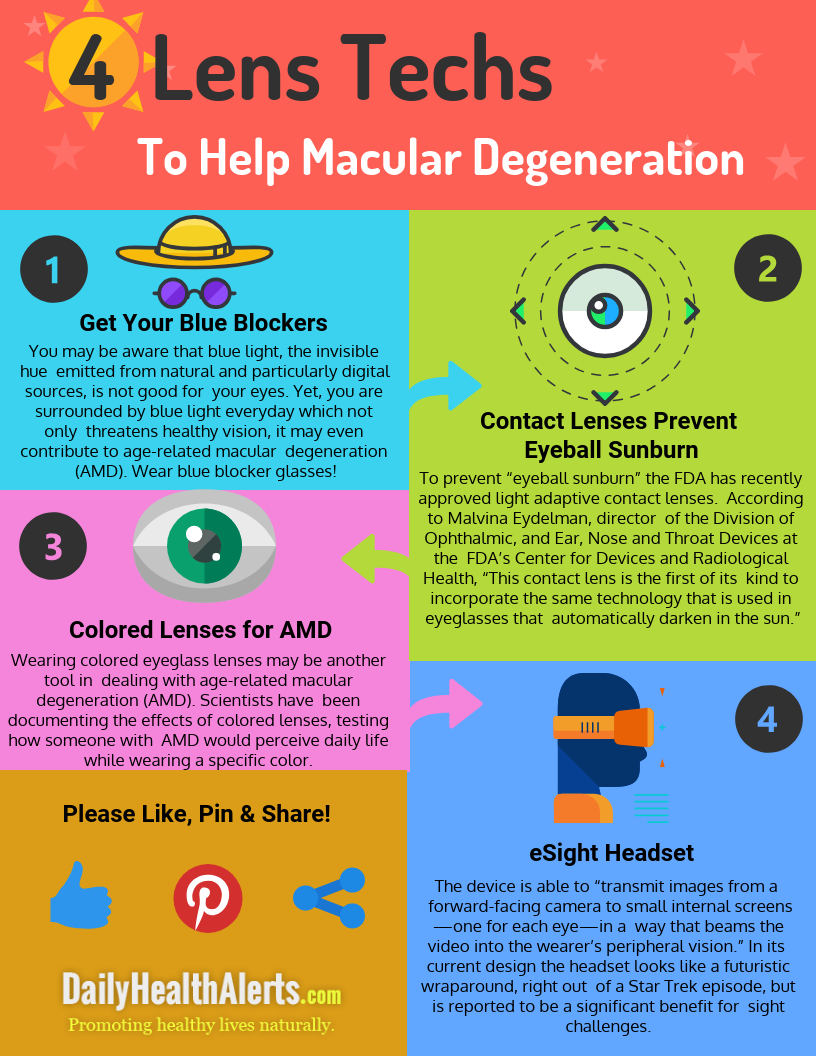When your sight is compromised by macular degeneration, doing anything you can to keep what vision you have left becomes paramount. Various supplements and foods that contain eye health vitamins and minerals are recommended. These would include highly studied supplements such as beta-carotene, zinc, copper, lycopene, carnosic acid, astaxanthin, lutein and zeaxanthin. In addition to natural supplementation, using visual tools to help you along can also be a big help.
These 4 lens techs for macular degeneration are some of many tools you can utilize to make your life a little easier as well as protect your sight from rapid degeneration. A variety of eyewear has been developed that may help keep you on-point when all seems like it’s going to end up in a blur way too soon. Special lenses for macular degeneration are another ray of hope as researchers continue to forge through study after study and treatment after treatment to stop macular degeneration once and for all.

Get Your Blue Blockers
You may be aware that blue light, the invisible hue emitted from natural and particularly digital sources, is not good for your eyes. Yet, you are surrounded by blue light everyday which not only threatens healthy vision, it may even contribute to age-related macular degeneration (AMD). Protecting yourself from the dangers of continued blue light exposure could be a good idea.
The International Review of Ophthalmic Optics cited in a 2014 paper, ‘The role of blue light in the pathogenesis of Age-related Macular Degeneration’ that,
Ophthalmologist Dr. Allen Mendelssohn describes what has been called “digital eye strain” and recommends you make sure your glasses have a blue blocker built in.
“There’s blue light that’s emitted from digital devices. That’s high energy visible light, but it’s harmful, and that’s what causes the digital eye strain,…Vision becomes blurry, eyes become fatigued, sometimes red, and it’s very frequent to start getting headaches,” Regarding blue blocker protection, Dr. Mendelssohn recommends a particular design, “Specifically it’s something called yellow chromophore pigment that’s embedded in the lens,”
Always purchase sunglasses with a high UV protection. There are three to choose from:
Some insurance companies will cover a yellow chromophore pigment addition otherwise it is estimated to cost around $100. However, the extra fee may be worth it, especially if you are a constant digital device user.
Contact Lenses Prevent Eyeball Sunburn
Wearing sunglasses to protect against sun exposure is highly recommended for protection and prevention against macular degeneration. However, sunglasses alone may not completely protect your eyes. There has been data suggesting that within the open sides of conventional sunglasses, no matter the UV protection of the lenses, sunlight can still penetrate the retina. In addition, minor exposure to a strong sunny reflective day, like at the beach, can actually sunburn your eyeballs which is called photokeratitis.
A United Press International report from 2016 stated,
“Cataracts and macular degeneration, both of which are linked to longer-term eye damage, are just as big a risk as sunburn on the eye, called photokeratitis, or growths on the eye, known as pterygium — both of which can be caused by as little as a few hours of exposure to intense, unblocked sunlight.”
To prevent “eyeball sunburn” the FDA has recently approved light adaptive contact lenses.
According to Malvina Eydelman, director of the Division of Ophthalmic, and Ear, Nose and Throat Devices at the FDA’s Center for Devices and Radiological Health,
“This contact lens is the first of its kind to incorporate the same technology that is used in eyeglasses that automatically darken in the sun,”
The brand cleared by the FDA is The Acuvue Oasys Contact Lenses with Transitions Light Intelligent Technology. These lenses were tested in a clinical study of twenty-four patients and are described as:
Jessica Lee, a board-certified ophthalmologist, and assistant professor of ophthalmology at the Icahn School of Medicine at Mount Sinai in New York City commented,
“Because these contact lenses reduce the amount of UV light reaching the lens and the retina (the back of the eye), they may help to reduce the risk of developing cataracts and age-related macular degeneration,”
Colored Lenses for AMD
Wearing colored eyeglass lenses may be another tool in dealing with age-related macular degeneration (AMD). Scientists have been documenting the effects of colored lenses, testing how someone with AMD would perceive daily life while wearing a specific color.
Researchers at the Neurosciences Research Institute, School of Life and Health Sciences, Aston University, Birmingham, UK used yellow, orange and gray lenses applied to three different control groups. The lenses were each worn for five days at a time with the following being measured:
The study conclusion stated that,
“The subjective benefit of colored lenses appears to be due to a minor enhancement of contrast sensitivity.”
It turns out that yellow is the most effective lens color which:
eSight Headset
With technology advancing at rapid speeds it is the innovation of prototypes that are the cornerstone of progress. For macular degeneration and other debilitating eye diseases, recent development of an eSight headset are showing promise.
The device is able to “transmit images from a forward-facing camera to small internal screens—one for each eye—in a way that beams the video into the wearer’s peripheral vision.” In its current design the headset looks like a futuristic wraparound, right out of a Star Trek episode, but is reported to be a significant benefit for sight challenges.
PhysOrg reports that,
“ESight believes that about 200 million people worldwide with visual acuity of 20/70 to 20/1200 could be potential candidates for its glasses. That number includes people with a variety of disabling eye conditions such as macular degeneration, diabetic retinopathy, ocular albinism, Stargardt’s disease, or, like Regan, optic nerve hypoplasia.”
More and more adaptive technology for macular degeneration and other visual diseases is being developed each year. With advancement in medicine, alternative remedies, diet, and gene therapy these adjunct tools are making it easier to cope with what was once though of as a hopeless visual compromise.